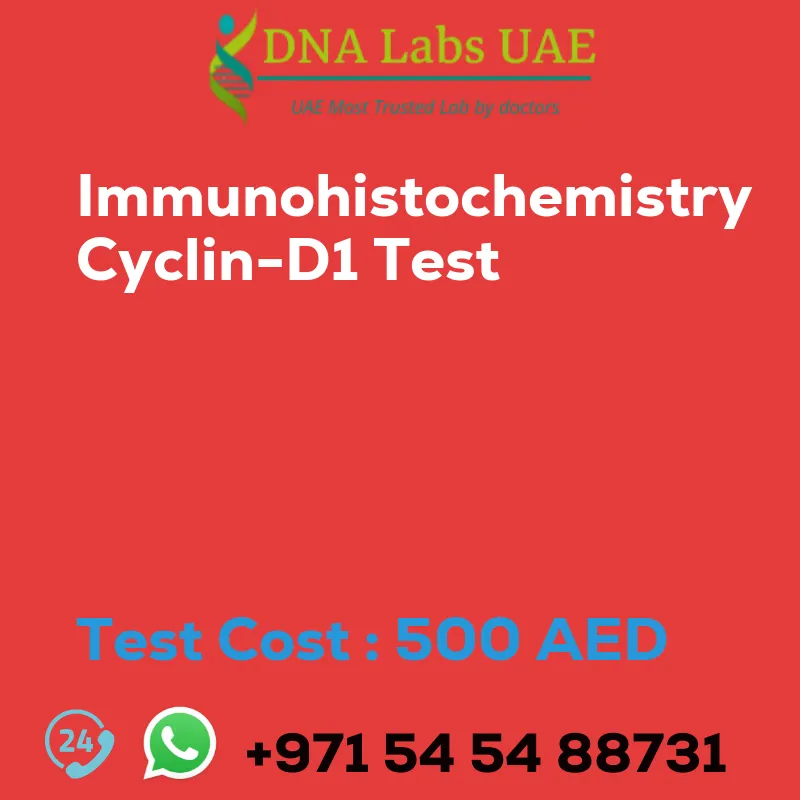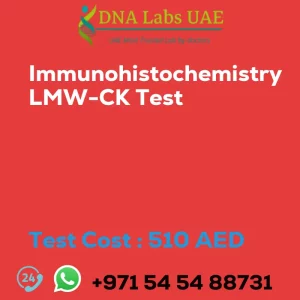IMMUNOHISTOCHEMISTRY CYCLIN-D1 Test
Test Name: IMMUNOHISTOCHEMISTRY CYCLIN-D1 Test
Components: Immunohistochemistry
Price: 500.0 AED
Sample Condition: Submit tumor tissue in 10% Formal-saline OR Formalin fixed paraffin embedded block. Ship at room temperature. Provide a copy of the Histopathology report, Site of biopsy and Clinical history.
Report Delivery: Sample Daily by 6 pm; Report Block: 5 days Tissue Biopsy: 5 days Tissue large complex: 7 days
Test Type: Cancer
Doctor: Oncologist, Pathologist
Test Department: Pre Test Information
Pre Test Information: Provide a copy of the Histopathology report, Site of biopsy and Clinical history.
Test Details
Immunohistochemistry (IHC) is a technique used to detect and visualize specific proteins in tissue samples. The cyclin D1 protein is involved in regulating the cell cycle and is often overexpressed in various types of cancer. The cyclin D1 IHC test involves the following steps:
- Tissue fixation: The tissue sample is collected and fixed using formalin or other fixatives to preserve its structure.
- Tissue processing: The fixed tissue is embedded in paraffin wax and sectioned into thin slices using a microtome.
- Deparaffinization: The paraffin wax is removed from the tissue sections using xylene or other clearing agents.
- Antigen retrieval: The tissue sections are treated with heat or enzymatic methods to unmask the antigens and improve their accessibility.
- Blocking: Non-specific binding sites on the tissue sections are blocked using serum or other blocking agents.
- Primary antibody incubation: The tissue sections are incubated with a primary antibody specific to cyclin D1. The primary antibody recognizes and binds to the cyclin D1 protein if it is present in the tissue.
- Secondary antibody incubation: The tissue sections are then incubated with a secondary antibody conjugated to a detection system, such as an enzyme or fluorescent molecule. The secondary antibody binds to the primary antibody, amplifying the signal.
- Visualization: The detection system produces a visible signal that can be visualized under a microscope. Enzyme-based detection systems often involve the addition of a chromogenic substrate, which produces a colored reaction product at the site of the cyclin D1 protein.
- Counterstaining: To enhance the contrast and visualization of the tissue sections, a counterstain, such as hematoxylin, may be applied.
- Analysis: The stained tissue sections are examined under a microscope by a pathologist or researcher to determine the presence and localization of cyclin D1 protein expression. The intensity and distribution of staining can provide information about the role of cyclin D1 in the tissue sample.
The cyclin D1 IHC test is commonly used in cancer diagnosis, prognosis, and treatment planning. It can help identify cyclin D1 overexpression, which is often associated with increased cell proliferation and tumor growth.
| Test Name | IMMUNOHISTOCHEMISTRY CYCLIN-D1 Test |
|---|---|
| Components | |
| Price | 500.0 AED |
| Sample Condition | Submit tumor tissue in 10% Formal-saline OR Formalin fixed paraffin embedded block. Ship at room temperature. Provide a copy of the Histopathology report, Site of biopsy and Clinical history. |
| Report Delivery | Sample Daily by 6 pm; Report Block: 5 days Tissue Biopsy: 5 days Tissue large complex : 7 days |
| Method | Immunohistochemistry |
| Test type | Cancer |
| Doctor | Oncologist, Pathologist |
| Test Department: | |
| Pre Test Information | Provide a copy of the Histopathology report, Site of biopsy and Clinical history. |
| Test Details |
Immunohistochemistry (IHC) is a technique used to detect and visualize specific proteins in tissue samples. The cyclin D1 protein is involved in regulating the cell cycle and is often overexpressed in various types of cancer. The cyclin D1 IHC test involves the following steps: 1. Tissue fixation: The tissue sample is collected and fixed using formalin or other fixatives to preserve its structure. 2. Tissue processing: The fixed tissue is embedded in paraffin wax and sectioned into thin slices using a microtome. 3. Deparaffinization: The paraffin wax is removed from the tissue sections using xylene or other clearing agents. 4. Antigen retrieval: The tissue sections are treated with heat or enzymatic methods to unmask the antigens and improve their accessibility. 5. Blocking: Non-specific binding sites on the tissue sections are blocked using serum or other blocking agents. 6. Primary antibody incubation: The tissue sections are incubated with a primary antibody specific to cyclin D1. The primary antibody recognizes and binds to the cyclin D1 protein if it is present in the tissue. 7. Secondary antibody incubation: The tissue sections are then incubated with a secondary antibody conjugated to a detection system, such as an enzyme or fluorescent molecule. The secondary antibody binds to the primary antibody, amplifying the signal. 8. Visualization: The detection system produces a visible signal that can be visualized under a microscope. Enzyme-based detection systems often involve the addition of a chromogenic substrate, which produces a colored reaction product at the site of the cyclin D1 protein. 9. Counterstaining: To enhance the contrast and visualization of the tissue sections, a counterstain, such as hematoxylin, may be applied. 10. Analysis: The stained tissue sections are examined under a microscope by a pathologist or researcher to determine the presence and localization of cyclin D1 protein expression. The intensity and distribution of staining can provide information about the role of cyclin D1 in the tissue sample. The cyclin D1 IHC test is commonly used in cancer diagnosis, prognosis, and treatment planning. It can help identify cyclin D1 overexpression, which is often associated with increased cell proliferation and tumor growth. |







